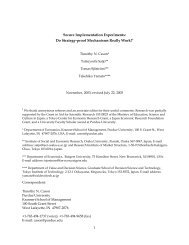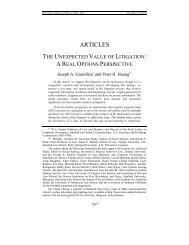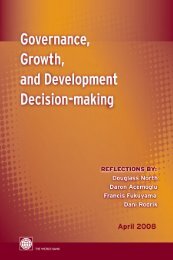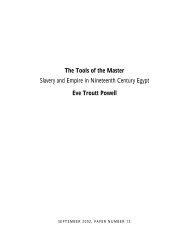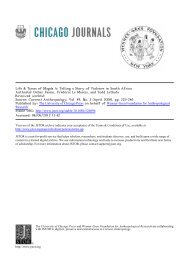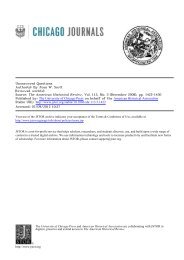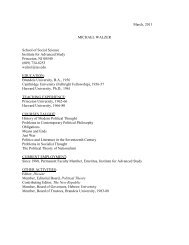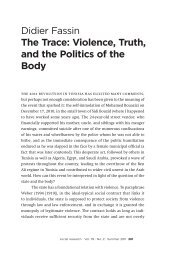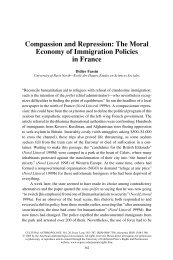Peter H. Huang Harold E. Kohn Chair Professor of Law James ...
Peter H. Huang Harold E. Kohn Chair Professor of Law James ...
Peter H. Huang Harold E. Kohn Chair Professor of Law James ...
You also want an ePaper? Increase the reach of your titles
YUMPU automatically turns print PDFs into web optimized ePapers that Google loves.
Emotional Impact Analysis<br />
and mergers and acquisitions, individual debt, market liquidity, and securities demand. In other words,<br />
“[s]tock market prices reflect both (fundamental) value and sentiment.” 96 Seventy years ago, a famous<br />
macroeconomist John Maynard Keynes utilized the phrase “animal spirits” to describe investor optimism<br />
or pessimism when he stated that:<br />
Even apart from the instability due to speculation, there is the instability due to the<br />
characteristic <strong>of</strong> human nature that a large proportion <strong>of</strong> our positive activities depend on<br />
spontaneous optimism rather than mathematical expectations, whether moral or<br />
hedonistic or economic. Most, probably, <strong>of</strong> our decisions to do something positive, the<br />
full consequences <strong>of</strong> which will be drawn out over many days to come, can only be taken<br />
as the result <strong>of</strong> animal spirits - a spontaneous urge to action rather than inaction, and not<br />
as the outcome <strong>of</strong> a weighted average <strong>of</strong> quantitative benefits multiplied by quantitative<br />
probabilities. 97<br />
Noted economist John Kenneth Galbraith believed there is not much that securities regulators can<br />
do about financial euphoria. 98 In contrast, several legal scholars have proposed that securities regulators<br />
can and should regulate financial market euphoria. 99<br />
Recent evidence suggests that relationships between emotional considerations and financial<br />
economic variables not only exist, but also run surprisingly in both directions. There is a growing body<br />
<strong>of</strong> intriguing empirical data demonstrating that local astronomical and meteorological conditions are<br />
correlated with market index returns on international financial exchanges. 100 There is medical and<br />
Ge<strong>of</strong>frey Tate, Does Overconfidence Affect Corporate Investment? CEO Overconfidence Measures Revisited, 11<br />
EUR. FIN. MGMT. 649 (2005) (presenting supplementary evidence about how CEO portrayals in popular financial<br />
press are related to overconfident investment decisions); Rajnish Mehra & Raaj Sah, Mood Fluctuations, Projection<br />
Bias, and Volatility <strong>of</strong> Equity Prices, 26 J. ECON. DYNAMICS & CONTROL 869 (2002); John R. N<strong>of</strong>singer, Social<br />
Mood and Financial Economics, 6 J. BEHAV. FIN. 144, 147-49, 152-55, 157-58 (2005); JOHN R. NOFSINGER, THE<br />
PSYCHOLOGY OF INVESTING 86-96 (2d ed. 2005); Richard L. <strong>Peter</strong>son, Buy on the Rumor: Anticipatory Affect and<br />
Investor Behavior 3 J. PSYCHOL. & FIN. MARKETS 218 (2002); and Richard J. Rosen, Merger Momentum and<br />
Investor Sentiment: The Stock Market Reaction to Merger Announcements, 79 J. BUS. 987 (2006).<br />
96 Kenneth L. Fisher & Meir Statman, Sentiment, Value, and Market-Timing, FIN. ANALYSTS J., Fall 2004, at 10.<br />
97 JOHN MAYNARD KEYNES, THE GENERAL THEORY OF EMPLOYMENT , INTEREST AND MONEY 161-62 (1936).<br />
98 JOHN KENNETH GALBRAITH, A SHORT HISTORY OF FINANCIAL EUPHORIA108 (1993).<br />
99 See e.g., Theresa A. Gabaldon, The Role <strong>of</strong> <strong>Law</strong> in Managing Market Moods: The Whole Story <strong>of</strong> Jason, Who<br />
Bought High, 69 GEO. WASH. L. REV. 111 (2000); Theresa A. Gabaldon, John <strong>Law</strong>, With A Tulip, In the South Seas:<br />
Gambling and the Regulation <strong>of</strong> Euphoric Market Transactions, 26 J. CORP. L. 225 (2001); and Donald C.<br />
Langevoort, Taming the Animal Spirits <strong>of</strong> the Stock Markets: A Behavioral Approach to Securities Regulation, 97<br />
NW. U. L. REV. 135 (2002).<br />
100 See e.g., Melanie Cao & Jason Wei, Stock Market Returns: A Note on Temperature Anomaly, J. BANKING & FIN.<br />
(2002) (finding that for eight international stock markets, returns are statistically significantly and negatively<br />
correlated with temperature); Melanie Cao & Jason Wei, An Expanded Study <strong>of</strong> the Stock Market Temperature<br />
Anomaly 22 RES. IN FIN. 73 (2005) (expanding on and confirming their previous research to include nineteen<br />
additional financial markets); Ilia D. Dichev & Troy D. Janes, Lunar Cycle Effects in Stock Returns, J. PRIVATE<br />
16



